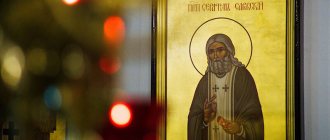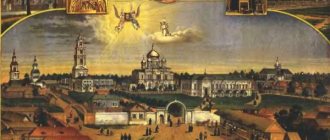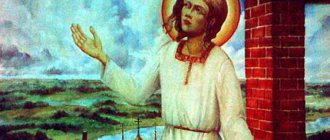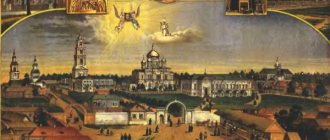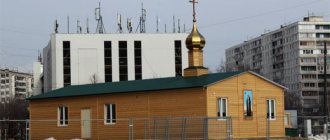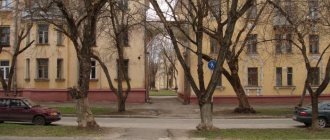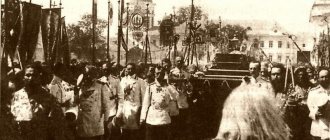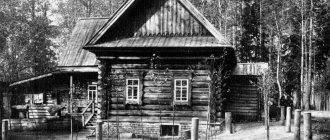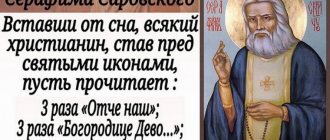Those who hear for the first time about the underground temple of St. Seraphim of Sarov have many questions. And the first one is what does this place look like? In the imagination, something immediately appears that looks like the long catacombs of the Vatican - full of mysteries and illuminated by torches.
| Underground temple of St. Seraphim of Sarov | |
| A country | Russia |
| City | Tula |
| Year of foundation | 1905 |
| Website | prep-sergiy.cerkov.ru |
| Abbot | Archpriest Vyacheslav Kovalevsky |
But what exactly is this temple? Is it as gloomy as we pictured, or, on the contrary, does this place pacify and make the soul rejoice?
The Temple of Seraphim of Sarov is located in the basement of the Church of Sergius of Radonezh
Tula, Zarechensky district. Somewhere here, as you can easily find out from local residents, is that same underground temple.
But if we ask for directions, they will show us a completely different church - bright, above ground and dedicated, as it is not surprising. Sergei Radonezhsky.
It's some kind of mistake? Not at all. Indeed, the Church of St. Sergius of Radonezh is our main landmark. After all, it is in its basement that the sanctuary of St. Seraphim of Sarov is located.
Both temples are located in the same building.
And we’ll talk further about how this happened.
The history of the underground temple of St. Seraphim of Sarov cannot be separated from the history of the main temple, since they form a single building.
Hospice
Once upon a time there was a kind of nursing home and shelter for street children attached to the church. In 1914, documentary information indicated that there were more than 130 people in the shelter.
There were only two people serving in the church - the priest and the psalm-reader. At the temple there was a small chapel named in the name of St. Theodosius of Chernigov. It was located on the newly built Trading Rows.
At that time, a popular local publication called “Tula Diocesan Gazette” had a large circulation. This newspaper repeatedly described the Church of St. Seraphim of Sarov in Tula and reported that this church, despite its small size and inconspicuous appearance, was always especially clean and cozy. This shows that the parishioners loved and cared about their church.
The temple was built at the end of the 19th century at an orphanage
It all started in 1891, when Archbishop Sergius turned to the Tula Duma with a request to give him one specific plot of land. Vladyka intended to create a whole complex of organizations there:
- parochial school;
- orphanage;
- vocational children's school;
- church.
Church of St. Sergius of Radonezh in an old photograph
The Archbishop did not ask for funding or assistance. He only needed land, and he was going to handle the rest with his own resources.
The Duma readily agreed and approved the priest’s idea, but he did not have time to complete what he started: he died.
Archbishop Sergius's successor in this matter was Archpriest Mikhail (Rozhdestvensky).
In 1891, the territory was fenced off and the necessary materials began to be collected. A year later, a couple of two-story buildings were erected on this land, and a year later, they were completely finished inside.
The plan of Archbishop Sergius was gradually realized, and corresponding institutions were opened in both buildings:
- northern building (lower floor) - parochial school;
- northern building (top floor) - living quarters for teachers;
- southern building (lower floor) - craft workshop;
- southern building (top floor) - living quarters for orphans.
1898 — 1899
during this time, the Church of St. Sergius of the Nativity and the bell tower were erected and opened
Around 1898, the Church of St. Sergius of the Rozhdestvensky and the bell tower were built here, and they were opened in 1989. Archpriest Mikhail became the first rector.
Children mastered turning and metalworking skills, and their work was sold. Three quarters of the proceeds helped maintain the entire complex, and the remaining quarter was set aside for the release of children.
Subsequently, a parish school for girls and a small hospital were opened there, where the poor were served free of charge.
The throne of Seraphim of Sarov did not exist in the temple until the 90s of the 20th century
If you try to reconstruct the history of the temple using information on the Internet, confusion will arise very quickly. The dating of the buildings does not agree, the facts do not coincide. There is nothing surprising, because there are many churches in Tula - including St. Seraphim of Sarov.
Unscrupulous sources report, in particular, that the throne in the basement almost immediately after construction was consecrated in honor of Seraphim of Sarov.
The Throne of Seraphim of Sarov was not originally in the temple.
This is, of course, not true.
Although the saint had long been revered in our country, he was canonized only in 1903 on the initiative of Nicholas II.
The Tula temple indeed had several boundaries, but they were not illuminated in honor of this saint. Here is a list of those limits that actually existed:
- St. Sergius of Radonezh;
- holy healer Panteleimon;
- Kazan Icon of the Mother of God;
- Saint Nicholas.
Everything else is fiction and delusion. Thus, a basement room in the temple existed, but it had nothing to do with Seraphim of Sarov. In Tula there was another, above-ground temple in honor of this saint.
Temple of Sergius of Radonezh in Tula
The church initially operated without a parish, and was attended by orphan boys from the school.
Current state
In 2002, the parish of the church of St. Seraphim of Sarov, the city authorities adopted a resolution on the transfer of the temple to believers.
On October 4, 2002, the first liturgy after the transfer of the temple took place.
Currently in the church of St. Seraphim of Sarov services are held every day. The restoration of the external and internal appearance of the temple is gradually underway.
The city authorities gave the parish a small house where a baptismal church, a Sunday school, a library and a refectory are temporarily located.
There is no utility and administrative premises. In 2012, construction began on the church house, which will have spacious premises for all the needs of the parish.
In the 30s, the Church of Sergius of Radonezh was closed
In the 10s of the 20th century, a dark streak began in the life of the temple. In 1915, Archpriest Mikhail died, and a revolution was just around the corner, which brought a lot of trouble to the believers of our country.
In 1929, authorities ordered the temple to be closed. According to the papers, it turned out that this order was for the good - the premises were being confiscated for cultural needs. But the Orthodox did not like this prospect.
L.M. writes about these events in the book “How Russian Temples Perished.” Zakharova:
“The state archive preserves the petition of the residents of Zarechye to the city council to leave the St. Sergius Church to the believers.
Several sheets of paper were signed by 1,304 residents of Tula, indicating their age and home address. These are mainly residents of Oktyabrskaya Street.
In another petition, 184 residents of Kurulovka asked not to dismantle the bell tower of the Sergius Church, since the ringing of the bells replaced their clocks.”
But no one wanted to listen to the people’s opinion, and in 1930 the temple was closed. But for what purpose, they couldn’t decide for a long time.
The authorities destroyed the bell tower, against the will of local residents.
There they organized either a tobacco warehouse, a transit prison, a utility room for the military, etc.
But the Bolsheviks decided not to preserve the bell tower and mercilessly destroyed it.
Perhaps demolishing the church would be too expensive. At least, it was this reason that prevented it from being destroyed later - in 1980, when they were preparing for the Olympics.
Restored Church of St. Sergius of Radonezh
The authorities figured out what would be cheaper for them: to improve the building or completely dismantle it. The first option turned out to be more economical. He was given preference.
So the Church of Sergei of Radonezh survived until the saving 90s, when the entire Orthodox (and not only) world calmly exhaled and felt safe.
In 1991, the temple was returned to believers, and soon the lower altar was consecrated in honor of Seraphim of Sarov
And in 1991, the new authorities began to treat religion much warmer. They saw in the old church no longer a relic of the past or an attribute of obscurantism, but, at a minimum, a monument of history and culture.
1991
this year the building was returned to the Tula diocese
By that time, the temple had changed significantly. It was impossible to understand what was in it and where it was. And there are no more people left who could remember anything. We had to rebuild the sanctuary literally from scratch.
Archpriest Vyacheslav (Kovalevsky) turned to Metropolitan Serapion and asked in whose honor the boundary in the basement should be consecrated. There could be many options, but the nearby churches already had boundaries in honor of the saints that came to mind first:
- Nicholas the Wonderworker;
- Mother of God.
But the answer came on its own. At that time, the relics of St. Seraphim of Sarov were found, so the idea of consecrating the limit in the basement in his honor seemed most appropriate and pleasing to God.
This “neighborhood” of Saints Sergius of Radonezh and Seraphim of Sarov looks like God’s providence. Could it have happened without him? After all, both of these elders are the main saints in Russian Orthodox history.
Metropolitan Serapion gave his blessing to consecrate the thrones in honor of these two saints.
The basement had to be deepened to increase the height of the temple
It is unlikely that we will ever be able to find out exactly what the basement in the old church looked like. But in Soviet times it was a simple firehouse where coal was stored. The building was heated from here.
To equip the Church of St. Seraphim of Sarov here, it was necessary to dig - this is how the height of the walls of the room was increased to four meters.
As a result, after many years of destruction and long restoration efforts, a building appeared in honor of the two saints. According to tradition, it has one abbot - Vyacheslav Kovalevsky.
Pilgrim
The rector of the temple is Archpriest Sergiy Mosyagin.
Divine Liturgy at 8-00, evening service at 17-00.
Every Sunday at 17-00 an akathist is read to St. Seraphim of Sarov with the distribution of blessed crackers.
Every Monday at 5:00 p.m. an akathist to St. Spyridon of Trimythous is read, every Thursday at 5:00 p.m. an akathist to St. Nicholas, every Friday an akathist to the Mother of God “Tenderness.”
On the last Friday of the month at 5 p.m., a water-blessing prayer service is served with an akathist to the “Inexhaustible Chalice” icon of the Mother of God.
There is a small children's playground in the courtyard of the temple.
The upper and lower temple complement each other
The Temple of St. Sergius of Radonezh is a magnificent building that seems to illustrate the inner wealth of a spiritually mature person.
Inside you can feel the solemnity of staying in faith, the power of the Creator, his saints and angels. It is obvious here - there, in heaven, and in each of us, there are protective forces, whose help helps us not to be afraid of anything.
And at the same time, the Temple of Sergius of Radonezh is an entrance, a barrier, a connecting link between the underground sanctuary and the outside world. That is why all organizational issues are resolved here.
Painting of the Church of St. Sergius of Radonezh
Associated with the temple:
- video library with cinema hall;
- Sunday school (concerts, Orthodox disciplines);
- ;
- water sanctuary;
- chapel;
- belfry
The following shrines are kept here:
- icon of St. Sergius of Radonezh and a particle of relics;
- icon of St. Seraphim of Sarov and a particle of relics;
- icon of St. Luke of Voino-Yasenetsky and a particle of relics;
- icon of the Great Martyr Panteleimon and a particle of relics;
- icon of St. Nicholas and a particle of relics;
- icon of Blessed John of Tula and a particle of relics.
If the upper church is stunning with beautiful paintings, solemn, like an Orthodox service, then the lower one looks very laconic and quiet, like a spirit-filled mind that has discarded unnecessary thoughts.
The Church of St. Seraphim of Sarov does not have wall paintings; it is nondescript and even ascetic. This is quite consistent with the nature of the holy elder himself, who spent many years in asceticism and valued the internal content, not the external.
There is nothing here to distract a person from sublime thoughts. This is a place where you can immerse yourself in order to hear the voice of God within.
If someone comes here with the idea of seeing a dark dungeon, then their expectations will not be met, but this person is unlikely to leave disappointed.
Interior of the underground temple in honor of St. Seraphim of Sarov
This place can charge you with spiritual energy, set you up for positive thoughts and strengthen your faith.
Perhaps it is natural and correct that it is here, in a place hidden from prying eyes, that the sacrament of baptism takes place.
Sunday School
When the chapel began operating, 3 Sunday schools were opened. Since 1992, only one school has been operating. The main Orthodox sciences are taught here. Various clubs and creative evenings were organized for children. Now they organize holiday meetings and concerts for their parents.
The school educates children from 6 to 15 years old.
The following subjects are taught in Sunday school:
- Orthodox Catechism.
- Liturgics.
- Church Slavonic language.
- History of the Russian Church.
Between lessons, children are treated to tea. School hours are from 11:00 to 14:00.
From April 30, 2022, adult classes are offered on Sundays.
They study the following subjects:
- Fundamentals of Orthodox culture.
- Slavic church language.
Details can be found by calling 47-42-22.
Details about the activities of the temple can be found on the official website
Schedule of services:
- 7:30 - confession;
- 8:30 - liturgy;
- 18:30 - all-night vigil.
Baptism and funeral services are daily.
Wedding - on the due dates.
Official website of St. Sergius Church
More information about the times and dates of specific services can be found on the official website of the temple. There are also contacts for communication and other useful information.
The temple is located at: Tula, st. Oktyabrskaya, 76 (entrance to the lower church through the St. Sergius Church).
By leaving a comment, you accept the user agreement

